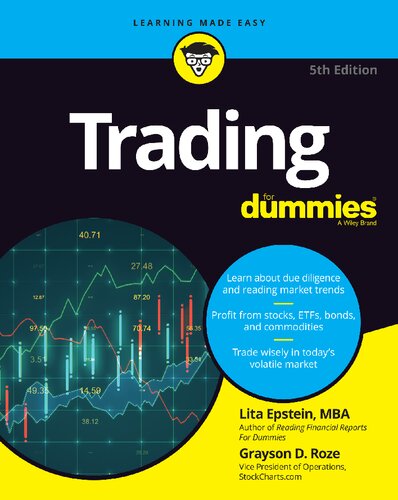Trading used to be the purview of institutional and corporate entities that had direct access to closed securities trading systems. Technical advances leveled the playing field, making securities trading much more accessible to individuals. After the stock market crash of 2000, when many people lost large sums of money because professional advisors or mutual fund managers didn’t protect their portfolio principal, investors chose one of two options — getting out of the market altogether and seeking safety or finding out more about how to manage their own portfolios. Many who came back into the market ran from it again in late 2008, when the market saw its worst year since the Great Depression. In 2017, the stock market roared to a high of the Dow Jones Index topping 21,000. The race up the ladder continued until it reached a high of 36,226 in December 2022, but then the next correction began. The Dow closed at 34,200 on November 25, 2022 — still considerably higher than the 2017 top of 21,000. The concept of buying and holding forever died after that 2000 stock crash; it saw some revival from 2004 to 2007 but then suffered another death in 2008. People today look for new ways to invest and trade. Although investors still prac- tice careful portfolio balancing using a buy-and-hold strategy, they look much more critically at what they’re holding and are more likely to change their hold- ings now than they were before the crash. Others have gotten out of the stock market completely. Still others have moved on to the world of trading. Many kinds of traders ply their skills in the markets. The ones who like to take on the most risk and want to trade as a full-time business look to day trading. They never hold a position in a security overnight. Swing traders hold their positions a bit longer, sometimes for a few days or even a few weeks. But we don’t focus on the riskier types of trading in this book; instead, we focus on position trading, which involves executing trades in and out of positions and holding positions for a few weeks or months and maybe even a year or more, depending on trends that are evident in the economy, the marketplace, and ultimately individual stocks
چکیده فارسی
تجارت قبلاً در حیطه اختیار نهادهای نهادی و شرکتی بود که دسترسی مستقیم به سیستم های معاملاتی بسته اوراق بهادار داشتند. پیشرفت های فنی زمین بازی را مساوی کرد و معاملات اوراق بهادار را برای افراد بسیار قابل دسترس تر کرد. پس از سقوط بازار سهام در سال 2000، زمانی که بسیاری از مردم مبالغ هنگفتی را از دست دادند زیرا مشاوران حرفهای یا مدیران صندوقهای سرمایهگذاری مشترک از اصل پرتفوی خود محافظت نکردند، سرمایهگذاران یکی از این دو گزینه را انتخاب کردند - خروج کامل از بازار و جستجوی امنیت یا پیدا کردن آن. بیشتر در مورد نحوه مدیریت پورتفولیوهای خود. بسیاری از کسانی که به بازار بازگشتند، در اواخر سال 2008، زمانی که بازار بدترین سال خود را از زمان رکود بزرگ مشاهده کرد، دوباره از آن فرار کردند. در سال 2017، بازار سهام به بالاترین سطح شاخص داوجونز رسید و به بالای 21000 رسید. صعود از نردبان ادامه یافت تا اینکه در دسامبر 2022 به 36226 رسید، اما پس از آن اصلاح بعدی آغاز شد. Dow در 25 نوامبر 2022 در 34200 بسته شد - هنوز هم به طور قابل توجهی بالاتر از بالای 21000 در سال 2017 است. مفهوم خرید و نگهداری برای همیشه پس از سقوط سهام در سال 2000 از بین رفت. از سال 2004 تا 2007 احیا شد، اما در سال 2008 مرگ دیگری را تجربه کرد. امروزه مردم به دنبال راههای جدیدی برای سرمایهگذاری و تجارت هستند. اگرچه سرمایهگذاران هنوز با استفاده از استراتژی خرید و نگهداشتن، متعادلسازی پرتفوی دقیقی را انجام میدهند، اما با نگاه انتقادیتری به آنچه در اختیار دارند نگاه میکنند و به احتمال زیاد اکنون نسبت به قبل از سقوط داراییهای خود را تغییر میدهند. برخی دیگر به طور کامل از بورس خارج شده اند. هنوز دیگران به دنیای تجارت رفته اند. بسیاری از انواع معامله گران مهارت های خود را در بازار به کار می برند. کسانی که دوست دارند بیشترین ریسک را بپذیرند و می خواهند به عنوان یک تجارت تمام وقت معامله کنند، به تجارت روزانه نگاه می کنند. آنها هرگز یک شبه در یک موقعیت امنیتی قرار نمی گیرند. معامله گران سوئینگ موقعیت های خود را کمی طولانی تر نگه می دارند، گاهی اوقات برای چند روز یا حتی چند هفته. اما ما در این کتاب روی انواع معاملات پرخطرتر تمرکز نمی کنیم. در عوض، ما بر معاملات موقعیت تمرکز می کنیم، که شامل انجام معاملات در داخل و خارج از موقعیت ها و حفظ موقعیت برای چند هفته یا ماه و شاید حتی یک سال یا بیشتر، بسته به روندهایی است که در اقتصاد، بازار، و در نهایت فردی مشهود است. سهام
ادامه ...
بستن ...
Author(s): Grayson D. Roze, Lita Epstein
Publisher: For Dummies, Year: 2023
ISBN: 1394161484,9781394161485
ادامه ...
بستن ...










